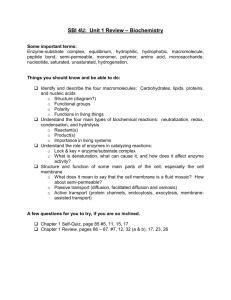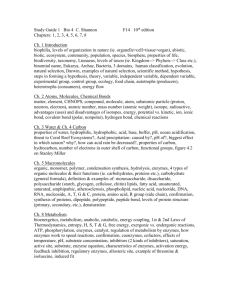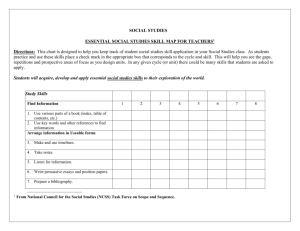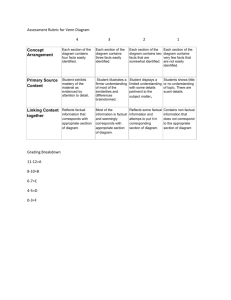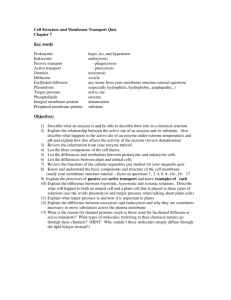Biology: Concepts and Connections, 6e (Campbell)
advertisement
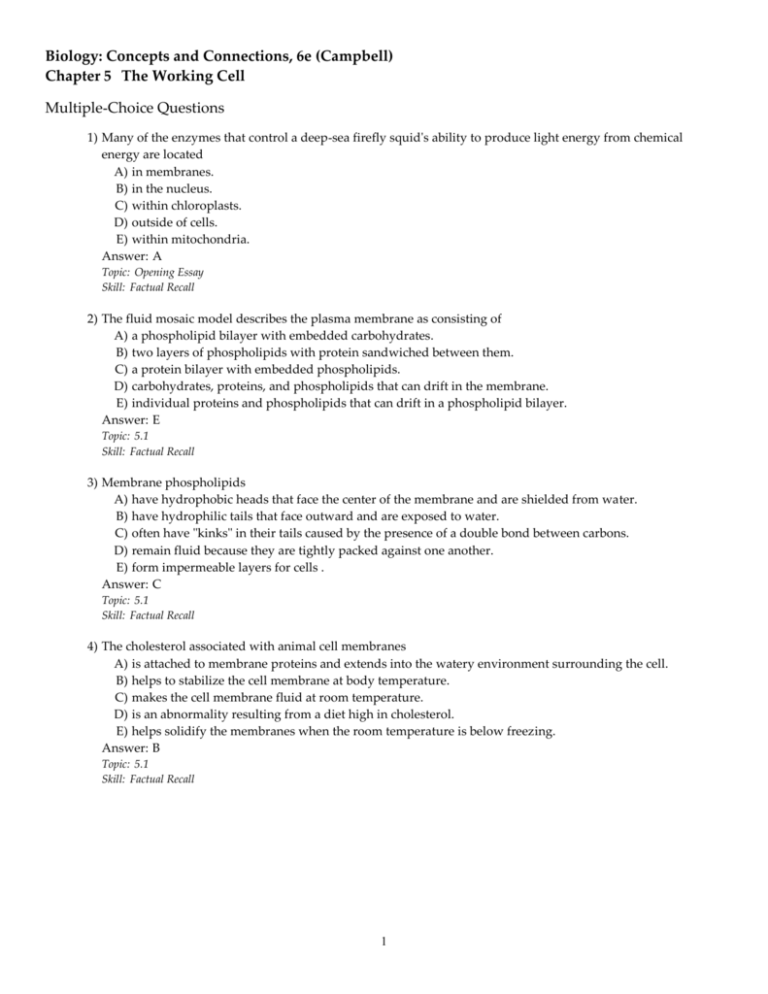
Biology: Concepts and Connections, 6e (Campbell) Chapter 5 The Working Cell Multiple-Choice Questions 1) Many of the enzymes that control a deep-sea firefly squid's ability to produce light energy from chemical energy are located A) in membranes. B) in the nucleus. C) within chloroplasts. D) outside of cells. E) within mitochondria. Answer: A Topic: Opening Essay Skill: Factual Recall 2) The fluid mosaic model describes the plasma membrane as consisting of A) a phospholipid bilayer with embedded carbohydrates. B) two layers of phospholipids with protein sandwiched between them. C) a protein bilayer with embedded phospholipids. D) carbohydrates, proteins, and phospholipids that can drift in the membrane. E) individual proteins and phospholipids that can drift in a phospholipid bilayer. Answer: E Topic: 5.1 Skill: Factual Recall 3) Membrane phospholipids A) have hydrophobic heads that face the center of the membrane and are shielded from water. B) have hydrophilic tails that face outward and are exposed to water. C) often have "kinks" in their tails caused by the presence of a double bond between carbons. D) remain fluid because they are tightly packed against one another. E) form impermeable layers for cells . Answer: C Topic: 5.1 Skill: Factual Recall 4) The cholesterol associated with animal cell membranes A) is attached to membrane proteins and extends into the watery environment surrounding the cell. B) helps to stabilize the cell membrane at body temperature. C) makes the cell membrane fluid at room temperature. D) is an abnormality resulting from a diet high in cholesterol. E) helps solidify the membranes when the room temperature is below freezing. Answer: B Topic: 5.1 Skill: Factual Recall 1 5) A major function of glycoproteins and glycolipids in the cell membrane is to A) glue cells together to form tissues. B) allow the cells of an embryo to sort themselves into tissues and organs. C) attach the cell membrane to the cytoskeleton. D) help the cell resist swelling. E) help the cell retain its shape. Answer: B Topic: 5.1 Skill: Factual Recall 6) When physicians perform an organ transplant, they choose a donor whose tissues match those of the recipient as closely as possible. Which of the following cell components are being matched? A) plasma membrane phospholipids B) plasma membrane proteins C) cell-surface carbohydrates D) plasma membrane cholesterols E) cytoskeletal elements Answer: C Topic: 5.1 Skill: Application 7) Most of the functions of a cell membrane are performed by A) glycolipids. B) proteins. C) phospholipids. D) cholesterol. E) nucleotides. Answer: B Topic: 5.1 Skill: Factual Recall 8) Which of the following statements regarding membrane protein function is false? A) Membrane proteins serve as enzymes. B) Membrane proteins act as receptors to molecules like hormones. C) Membrane proteins provide cellular identification tags. D) Membrane proteins form junctions between cells. E) Membrane proteins transfer genetic information to the cytoplasm. Answer: E Topic: 5.1 Skill: Factual Recall 9) Relaying a message from a membrane receptor to a molecule that performs a specific function within a cell is called A) signal transduction. B) inhibition. C) competition. D) self-recognition. E) selective permeability. Answer: A Topic: 5.1 Skill: Factual Recall 2 10) Plasma membranes are selectively permeable. This means that A) anything can pass into or out of a cell as long as the membrane is intact and the cell is healthy. B) the plasma membrane allows some substances to enter or leave a cell more easily than others. C) glucose cannot enter the cell. D) cholesterol cannot enter the cell. E) plasma membranes must be very thick. Answer: B Topic: 5.1 Skill: Factual Recall 11) Which of the following statements regarding membrane function is false? A) The plasma membrane forms a selective barrier around the cell. B) The plasma membrane plays a role in signal transduction. C) The plasma membrane has receptors for chemical messages. D) The plasma membrane is the control center of the cell. E) The plasma membrane is involved in self-recognition. Answer: D Topic: 5.1 Skill: Factual Recall 12) Small, nonpolar, hydrophobic molecules such as fatty acids A) easily pass through a membrane's lipid bilayer. B) very slowly diffuse through a membrane's lipid bilayer. C) require transport proteins to pass through a membrane's lipid bilayer. D) are actively transported across cell membranes. E) usually enter the cell via endocytosis. Answer: A Topic: 5.1 Skill: Factual Recall 13) Which characteristic promoted the utilization of lipids as the first cell membrane? A) spontaneous degradation of the intracellular environment B) self-assembly into a simple membrane C) ability to form an impermeable membrane D) formation of a semi-solid membrane E) utilization of the hydrophilic nature of lipids Answer: B Topic: 5.2-Evolution Connection Skill: Conceptual Understanding 14) All cells are enclosed by a plasma membrane that is similar in ________ and ________. A) thickness . . . composition B) permeability . . . content C) proteins . . . lipids D) lucidity . . . texture E) structure . . . function Answer: E Topic: 5.2-Evolution Connection Skill: Factual Recall 3 15) Which of the following substances would have the most trouble crossing a biological membrane by diffusing through the lipid bilayer? A) H2O B) O2 C) CO2 D) Na+ E) a small, nonpolar molecule such as butane (C4H10) Answer: D Topic: 5.3 Skill: Factual Recall 16) Oxygen crosses a plasma membrane by A) osmosis. B) phagocytosis. C) active transport. D) pinocytosis. E) passive transport. Answer: E Topic: 5.3 Skill: Factual Recall 17) Which of the following statements regarding diffusion is false? A) Diffusion is a result of the kinetic energy of atoms and molecules. B) Diffusion is driven by concentration gradients. C) Diffusion requires no input of energy into the system. D) Diffusion occurs when particles spread from areas where they are less concentrated to areas where they are more concentrated. E) Diffusion occurs even after equilibrium is reached and no net change is apparent. Answer: D Topic: 5.3 Skill: Conceptual Understanding 18) Diffusion does not require the cell to expend ATP. Therefore, diffusion is considered a type of A) exocytosis. B) phagocytosis. C) passive transport. D) active transport. E) endocytosis. Answer: C Topic: 5.3 Skill: Conceptual Understanding 19) Osmosis can be defined as A) the diffusion of water. B) the diffusion of nonpolar molecules. C) active transport. D) the diffusion of a solute. E) endocytosis. Answer: A Topic: 5.4 Skill: Factual Recall 4 20) When two aqueous solutions that differ in solute concentration are placed on either side of a semipermeable membrane and osmosis is allowed to take place, the water will A) exhibit a net movement to the side with lower water concentration. B) exhibit a net movement to the side with higher water concentration. C) exhibit a net movement to the side with lower solute concentration. D) exhibit an equal movement in both directions across the membrane. E) not cross the membrane. Answer: A Topic: 5.4 Skill: Factual Recall 21) In the lab, you use a special balloon that is permeable to water, but not sucrose, to make an "artificial cell." The balloon is filled with a solution of 20% sucrose and 80% water and is immersed in a beaker containing a solution of 40% sucrose and 60% water. Which of the following will occur? A) Water will leave the balloon. B) Water will enter the balloon. C) Sucrose will leave the balloon. D) Sucrose will enter the balloon. E) Sucrose and water will pass across the balloon simultaneously. Answer: A Topic: 5.4 Skill: Application 22) Some protozoans have special organelles called contractile vacuoles that continually eliminate excess water from the cell. The presence of these organelles tells you that the environment A) is isotonic to the protozoan. B) is hypotonic to the protozoan. C) is contaminated with pollutants. D) contains a higher concentration of solutes than the protozoan. E) is hypertonic to the protozoan. Answer: B Topic: 5.4 Skill: Application 23) A cell that neither gains nor loses water when it is immersed in a solution is A) isotonic to its environment. B) hypertonic to its environment. C) hypotonic to its environment. D) metabolically inactive. E) dead. Answer: A Topic: 5.5 Skill: Factual Recall 24) In a hypotonic solution, an animal cell will A) lyse. B) experience turgor. C) neither gain nor lose water. D) shrivel. E) lose water. Answer: A Topic: 5.5 Skill: Application 5 25) If placed in tap water, an animal cell will undergo lysis, whereas a plant cell will not. What accounts for this difference? A) the expulsion of water by the plant cell's central vacuole B) the relative impermeability of the plant cell membrane to water C) the relative impermeability of the plant cell wall to water D) the fact that plant cells are isotonic to tap water E) the relative inelasticity and strength of the plant cell wall Answer: E Topic: 5.5 Skill: Factual Recall 26) In the lab, you use a special balloon that is permeable to water but not sucrose to make an "artificial cell." The balloon is filled with a solution of 20% sucrose and 80% water and is immersed in a beaker containing a solution of 40% sucrose and 60% water. The solution in the balloon is ________ relative to the solution in the beaker. A) isotonic B) hypotonic C) hypertonic D) hydrophobic E) hydrophilic Answer: B Topic: 5.5 Skill: Application 27) White blood cells (WBCs) are more resistant to lysis than red blood cells (RBCs). When looking at a sample of blood for WBCs, would could you do to reduce interference from RBCs? A) Mix the blood in a salty solution to cause the RBCs to lyse. B) Mix the blood in an isotonic solution and allow the WBCs to float to the top. C) Mix the blood with a dye that stains the proteins in the cytoplasm. D) Mix the blood in a hypotonic solution, which will cause the RBCs to lyse. E) Mix the blood in a hypertonic solution, which will cause the RBCs to lyse. Answer: D Topic: 5.5 Skill: Application 28) A plant cell in a hypotonic solution A) is turgid. B) lyses. C) shrivels. D) wilts. E) is flaccid. Answer: A Topic: 5.5 Skill: Factual Recall 6 29) You are adrift in the Atlantic Ocean, and, being thirsty, drink the surrounding seawater. As a result, A) you quench your thirst. B) your cells lyse, due to the excessive intake of salt. C) your cells become turgid. D) you dehydrate yourself. E) your cells lyse from excessive water intake. Answer: D Topic: 5.5 Skill: Application 30) Facilitated diffusion across a biological membrane requires ________ and moves a substance ________ its concentration gradient. A) energy and transport proteins . . . down B) energy . . . down C) transport proteins . . . down D) energy and transport proteins . . . against E) transport proteins . . . against Answer: C Topic: 5.6 Skill: Factual Recall 31) The molecules responsible for membrane transport are A) steroids. B) ATP. C) phospholipids. D) carbohydrates. E) proteins. Answer: E Topic: 5.6 Skill: Factual Recall 32) Which of the following statements is true among all types of passive diffusion? A) Proteins are needed to transport molecules across the membrane. B) The concentration gradient is the driving force. C) Only small polar molecules are able to cross the plasma membrane. D) Only small nonpolar molecules are able to cross the plasma membrane. E) Ions never cross the plasma membrane by passive transport. Answer: B Topic: 5.4, 5.5, 5.6 Skill: Factual Recall 33) Which of the following processes can move a solute against its concentration gradient? A) osmosis B) passive transport C) diffusion D) facilitated diffusion E) active transport Answer: E Topic: 5.7 Skill: Factual Recall 7 34) Which of the following processes could result in the net movement of a substance into a cell, if the substance is more concentrated in the cell than in the surroundings? A) active transport B) facilitated diffusion C) diffusion D) osmosis E) passive transport. Answer: A Topic: 5.8 Skill: Conceptual Understanding 35) Which of the following is a typical feature of an ATP-driven active transport mechanism? A) The transport protein must cross to the correct side of the membrane before the solute can bind to it. B) The solute must be phosphorylated before it can bind to the transport protein. C) The transport protein is irreversibly phosphorylated as transport takes place. D) The transport protein catalyzes the conversion of ADP to ATP. E) The solute moves against the concentration gradient. Answer: E Topic: 5.8 Skill: Conceptual Understanding 36) Which of the following statements regarding active transport is false? A) Active transport uses ATP as an energy source. B) Active transport can move solutes up a concentration gradient. C) Active transport requires the cell to expend energy. D) Active transport is driven by the concentration gradient. E) Active transport is necessary to allow nerves to function properly. Answer: D Topic: 5.8 Skill: Factual Recall 37) Certain cells that line the stomach synthesize a digestive enzyme and secrete it into the stomach. This enzyme is a protein. Which of the following processes could be responsible for its secretion? A) endocytosis B) exocytosis C) diffusion D) pinocytosis E) passive transport Answer: B Topic: 5.9 Skill: Factual Recall 38) The process of a white blood cell engulfing a bacterium is A) osmosis. B) diffusion. C) receptor-mediated endocytosis. D) pinocytosis. E) phagocytosis. Answer: E Topic: 5.9 Skill: Factual Recall 8 39) Phagocytosis is to eating as pinocytosis is to A) osmosis. B) drinking. C) chewing. D) hydrolysis. E) lysis. Answer: B Topic: 5.9 Skill: Factual Recall 40) Cells acquire LDLs by A) osmosis. B) diffusion. C) receptor-mediated endocytosis. D) pinocytosis. E) phagocytosis. Answer: C Topic: 5.9 Skill: Factual Recall 41) Kinetic energy differs from chemical energy in that A) kinetic energy is stored energy that has the potential to do work, and chemical energy is the energy of movement. B) kinetic energy depends on the movement of atoms, whereas chemical energy depends on the movement of molecules. C) kinetic energy can be converted into various forms of energy, whereas chemical energy can only be converted into heat. D) kinetic energy is the energy of a moving object, whereas chemical energy is the potential energy of molecules. E) chemical energy is a particular form of kinetic energy. Answer: D Topic: 5.10 Skill: Factual Recall 42) Glucose molecules provide energy to power the swimming motion of sperm. In this example, the sperm are changing A) chemical energy into kinetic energy. B) chemical energy into potential energy. C) kinetic energy into potential energy. D) kinetic energy into chemical energy. E) kinetic energy into thermal energy. Answer: A Topic: 5.10 Skill: Application 9 43) In the reaction A → B + C + heat, A) there is a net input of energy. B) the potential energy of the products is greater than that of the reactant. C) the potential energy of the products is the same as that of the reactant. D) the potential energy of the products is less than that of the reactant. E) entropy has decreased. Answer: D Topic: 5.10 Skill: Application 44) Which of the following statements regarding thermodynamics is false? A) Thermodynamics is the study of energy transformations that occur in a collection of matter. B) The collection of matter under study is called the system. C) A single cell or the planet Earth could be a thermodynamic system. D) An open system exchanges both energy and matter with its surroundings. E) An automobile engine is an example of a closed system. Answer: E Topic: 5.11 Skill: Factual Recall 45) According to ________, energy cannot be created or destroyed. A) Aristotle's first principle B) the first law of thermodynamics C) the second law of thermodynamics D) the third law of thermodynamics E) Einstein's law of relativity Answer: B Topic: 5.11 Skill: Factual Recall 46) A steer must eat at least 100 pounds of grain to gain less than 10 pounds of muscle tissue. This illustrates A) the first law of thermodynamics. B) the second law of thermodynamics. C) that some energy is destroyed in every energy conversion. D) that energy transformations are typically 100% efficient. E) that thermal energy can be transformed into chemical energy. Answer: B Topic: 5.11 Skill: Application 47) Which of the following energy transfers is impossible in living systems? A) light energy to chemical energy B) chemical energy to kinetic energy C) potential energy to kinetic energy D) light energy to potential energy E) heat to light energy. Answer: E Topic: 5.11 Skill: Conceptual Understanding 10 48) Living systems A) violate the first law of thermodynamics. B) violate the second law of thermodynamics. C) decrease their entropy while increasing the entropy of the universe. D) are examples of a closed system. E) are only compelled to follow the first law of thermodynamics. Answer: C Topic: 5.11 Skill: Conceptual Understanding 49) Which of the following processes is endergonic? A) the burning of wood B) the release of heat from the breakdown of glucose C) the synthesis of glucose from carbon dioxide and water D) the breakdown of glucose E) cellular respiration Answer: C Topic: 5.12 Skill: Conceptual Understanding 50) What is the basic difference between exergonic and endergonic reactions? A) Exergonic reactions involve ionic bonds; endergonic reactions involve covalent bonds. B) Exergonic reactions involve the breaking of bonds; endergonic reactions involve the formation of bonds. C) Exergonic reactions involve the formation of bonds; endergonic reactions involve the breaking of bonds. D) Exergonic reactions release energy; endergonic reactions absorb it. E) In exergonic reactions, the reactants have less chemical energy than the products; in endergonic reactions, the opposite is true. Answer: D Topic: 5.12 Skill: Conceptual Understanding 51) Which of the following statements concerning energy is false? A) Fireflies are able to take potential energy in the form of food and convert that energy into kinetic energy in the form of heat and light. B) A gasoline engine converts chemical energy into kinetic energy. C) Living systems convert heat energy into chemical energy to reduce entropy. D) Energy transformations in cells are accompanied by the release of heat energy. E) During photosynthesis, plants convert kinetic energy into chemical energy. Answer: C Topic: 5.12 Skill: Conceptual Understanding 52) Which of the following examples is classified as a metabolic pathway? A) protein synthesis B) osmosis C) cell lysis D) spontaneous combustions E) passive diffusion Answer: A Topic: 5.12 Skill: Conceptual Understanding 11 53) When a cell uses chemical energy to perform work, it couples a(n) ________ reaction with a(n) ________ reaction. A) exergonic . . . endergonic B) endergonic . . . exergonic C) exergonic . . . spontaneous D) spontaneous . . . exergonic E) endergonic . . . spontaneous Answer: A Topic: 5.12 Skill: Factual Recall 54) Which of the following statements about the ATP molecule is true? A) It contains two phosphate groups. B) Extremely stable bonds link the second and third phosphate groups. C) It contains the six-carbon sugar hexose. D) It contains a nitrogenous base molecule called adenine. E) It can be coupled with an exergonic reaction. Answer: D Topic: 5.13 Skill: Factual Recall 55) The transfer of a phosphate group to a molecule or compound is called A) carboxylation. B) ionization. C) phosphorylation. D) hydrogen bonding. E) hydrogenation. Answer: C Topic: 5.13 Skill: Factual Recall 56) Anything that prevents ATP formation will most likely A) result in cell death. B) force the cell to rely on lipids for energy. C) result in the conversion of kinetic energy to potential energy. D) force the cell to rely on ADP for energy. E) have no effect on the cell. Answer: A Topic: 5.13 Skill: Conceptual Understanding 57) ATP can be used as the cell's energy exchange mechanism because A) endergonic reactions can be fueled by coupling them with the formation of ATP from ADP. B) ATP is the most energy-rich small molecule in the cell. C) endergonic reactions can be fueled by coupling them with the hydrolysis of high-energy phosphate bonds in ATP. D) the regeneration of ATP from ADP can be fueled by coupling it with endergonic reactions. E) ATP is a disposable form of chemical energy, used once and then discarded by the cell. Answer: C Topic: 5.13 Skill: Factual Recall 12 58) An energy barrier A) is the amount of energy that must be produced by the reactants to start a chemical reaction. B) is higher than the energy of activation of a reaction. C) is lower than the energy of activation of a reaction. D) prevents the spontaneous decomposition of molecules in the cell. E) can only be overcome with the use of enzymes. Answer: D Topic: 5.14 Skill: Factual Recall 59) The energy required to initiate an exergonic reaction is called A) exergonic energy. B) endergonic energy. C) input energy. D) hydrolytic energy. E) the energy of activation. Answer: E Topic: 5.14 Skill: Factual Recall 60) Most of a cell's enzymes are A) lipids. B) proteins. C) amino acids. D) nucleic acids. E) carbohydrates. Answer: B Topic: 5.14 Skill: Factual Recall 61) When an enzyme catalyzes a reaction, A) it lowers the activation energy of the reaction. B) it raises the activation energy of the reaction. C) it becomes a product. D) it acts as a reactant. E) it is used once and discarded. Answer: A Topic: 5.14, 5.15 Skill: Factual Recall 62) Substrates bind to an enzyme's ________ site. A) reactant B) allosteric C) regulatory D) phosphate E) active Answer: E Topic: 5.15 Skill: Factual Recall 13 63) The active site of an enzyme is A) the region of a substrate that is changed by an enzyme. B) the highly changeable portion of an enzyme that adapts to fit the substrates of various reactions. C) the region of an enzyme that attaches to a substrate. D) the region of a product that detaches from the enzyme. E) the region of the enzyme composed of only a few specific nucleic acids. Answer: C Topic: 5.15 Skill: Factual Recall 64) Which of the following statements regarding enzyme function is false? A) An enzyme's function depends on its three-dimensional shape. B) Enzymes are very specific for certain substrates. C) Enzymes are used up in chemical reactions. D) Enzymes emerge unchanged from the reactions they catalyze. E) An enzyme binds to its substrate at the enzyme's active site. Answer: C Topic: 5.14, 5.15 Skill: Factual Recall 65) Which of the following statements regarding enzymes is true? A) Enzymes are inorganic. B) An enzyme's function is unaffected by changes in pH. C) Enzymes are the reactants in a chemical reaction. D) Enzymes catalyze specific reactions. E) All enzymes depend on protein cofactors to function. Answer: D Topic: 5.15 Skill: Factual Recall 66) A child is brought to the hospital with a fever of 107°F. Doctors immediately order an ice bath to lower the child's temperature. Which of the following statements offers the most logical explanation for this action? A) Elevated body temperature will increase reaction rates in the child's cells and overload the limited number of enzymes found in the cell. B) Elevated body temperatures may denature enzymes. This would interfere with the cell's abilities to catalyze various reactions. C) Elevated body temperatures will increase the energy of activation needed to start various chemical reactions in the body. This will interfere with the ability of enzymes to catalyze vital chemical reactions. D) Elevated body temperatures cause molecules to vibrate more quickly and prevent enzymes from easily attaching to reactants. This would slow vital body reactions. E) Elevated body temperatures easily break the covalent bonds linking biologically important molecules. This will cause a general breakdown of cell structures. Answer: B Topic: 5.15 Skill: Application 14 67) Heating inactivates enzymes by A) breaking the covalent bonds that hold the molecule together. B) removing phosphate groups from the enzyme. C) causing enzyme molecules to stick together. D) changing the enzyme's three-dimensional shape. E) inducing the addition of amino acids. Answer: D Topic: 5.15 Skill: Conceptual Understanding 68) Which of the following substances could be a cofactor? A) a protein B) a polypeptide C) a zinc atom D) a ribosome E) collagen Answer: C Topic: 5.15 Skill: Factual Recall 69) Which of the following is a coenzyme? A) zinc B) vitamin B6 C) iron D) iodine E) hydrogen ions Answer: B Topic: 5.16 Skill: Factual Recall 70) Which of the following will have no effect on the rate of an enzyme-catalyzed reaction? A) temperature B) pH C) competitive inhibitors D) noncompetitive inhibitors E) net change in energy Answer: E Topic: 5.16 Skill: Factual Recall 71) Inhibition of an enzyme is irreversible when A) a competitive inhibitor is involved. B) a noncompetitive inhibitor is involved. C) the shape of the enzyme is changed. D) covalent bonds form between inhibitor and enzyme. E) weak interactions form between inhibitor and enzyme. Answer: D Topic: 5.16 Skill: Factual Recall 15 72) How does inhibition of an enzyme-catalyzed reaction by a competitive inhibitor differ from inhibition by a noncompetitive inhibitor? A) Competitive inhibitors interfere with the enzyme; noncompetitive inhibitors interfere with the reactants. B) Competitive inhibitors bind to the enzyme reversibly; noncompetitive inhibitors bind to it irreversibly. C) Competitive inhibitors change the enzyme's tertiary structure; noncompetitive inhibitors cause polypeptide subunits to dissociate. D) Competitive inhibitors bind to the active site of the enzyme; noncompetitive inhibitors bind to a different site. E) Competitive inhibitors are inorganic substances such as metal ions; noncompetitive inhibitors are vitamins or vitamin derivatives. Answer: D Topic: 5.16 Skill: Factual Recall 73) Bacterial production of the enzymes needed for the synthesis of the amino acid tryptophan declines with increasing levels of tryptophan and increases as tryptophan levels decline. This is an example of A) competitive inhibition. B) noncompetitive inhibition. C) feedback inhibition. D) positive feedback. E) irreversible inhibition. Answer: C Topic: 5.16 Skill: Factual Recall 16 Art Questions 1) Which figure depicts an animal cell placed in a solution hypotonic to the cell? A) cell A B) cell B C) cell C D) cell D E) cell E Answer: A Topic: 5.4, 5.5 Skill: Conceptual Understanding 2) Which part of the ATP molecule breaks free of the rest when an ATP molecule is used for energy? A) part A B) part B C) part C D) part D E) part E Answer: E Topic: 5.13 Skill: Factual Recall 17 Scenario Questions After reading the following paragraph, answer the question(s) below. Americans spend up to $100 billion annually for bottled water (41 billion gallons). The only beverages with higher sales are carbonated soft drinks. Recent news stories have highlighted the fact that most bottled water comes from municipal water supplies (the same source as your tap water), although it may undergo an extra purification step called reverse osmosis. Imagine two tanks that are separated by a membrane that's permeable to water, but not to the dissolved minerals present in the water. Tank A contains tap water and Tank B contains the purified water. Under normal conditions, the purified water would cross the membrane to dilute the more concentrated tap water solution. In the reverse osmosis process, pressure is applied to the tap water tank to force the water molecules across the membrane into the pure water tank. 1) After the reverse osmosis system has been operating for 30 minutes, the solution in Tank A would A) be hypotonic to Tank B. B) be isotonic to Tank B. C) be hypertonic to Tank B. D) contain more minerals than Tank B. E) move by passive transport to Tank B. Answer: C Topic: 5.3, 5.4, 5.5, 5.8 Skill: Conceptual Understanding 2) If you shut the system off and pressure was no longer applied to Tank A, you would expect A) the water movement to follow the concentration gradient. B) the water to reverse flow from B to A. C) the water to flow in equal amounts in both directions. D) the water to flow against the concentration gradient. E) both a and b above to occur. Answer: E Topic: 5.3, 5.4, 5.5, 5.8 Skill: Application 18
